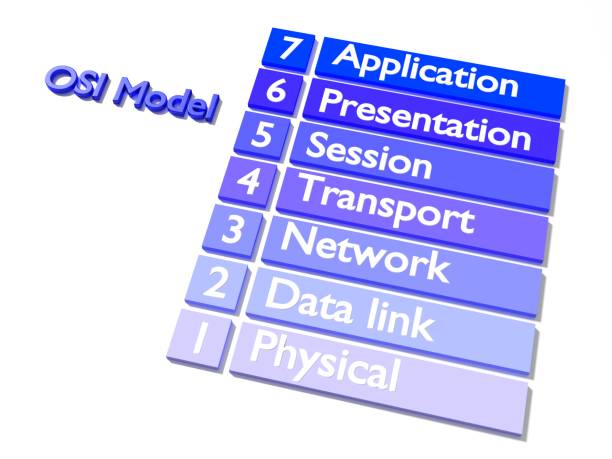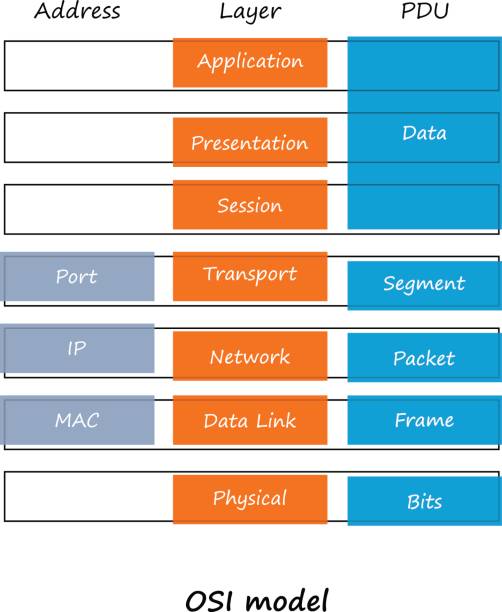The OSI Model (Open Systems Interconnection Model) is a conceptual framework used to describe the functions of a networking system.
Firstly, OSI consists of seven layers, and each layer performs a particular network function.
Secondly, the OSI model is divided into two layers: upper layers and lower layers.

- The upper layer of the OSI model mainly deals with the application related issues, and they are implemented only in the software.
- The lower layer of the OSI model deals with the data transport issues.
Above all, OSI model was developed by the International Organization for Standardization (ISO). And, it is now considered as an architectural model for the inter-computer communications.

Seven layers of the OSI Model :
1. Physical Layer
So, this is the lowest layer of OSI model.
It is responsible for the physical cable or wireless connection between network nodes.
The main functionality of the physical layer is to transmit the individual bits from one node to another node.
Also, it establishes, maintains and deactivates the physical connection.
In addition, we will see its function.
Functions of a Physical layer:
- Line Configuration
- Data Transmission
- Topology
- Signals
2. Data Link Layer
So, the data link layer establishes and terminates a connection between two physically-connected nodes on a network.
In short, it defines the format of the data on the network.
Moreover, this layer is responsible for the error-free transfer of data frames.
Also, it contains two sub-layers :
- Logical Link Control Layer
- Media Access Control Layer
Functions of the Data-link layer:
- Framing
- Physical Addressing
- Flow Control
- Error Control
- Access Control
3. Network Layer
Firstly, it is the third level of model.
The Data link layer is responsible for routing and forwarding the packets.
Subsequently, it manages device addressing, tracks the location of devices on the network.
Moreover, it determines the best path to move data from source to the destination based on the network conditions, the priority of service, and other factors.
Functions of Network Layer:
- Internetworking
- Addressing
- Routing
- Packetizing
4. Transport Layer
The transport layer is a Layer 4. Firstly, it ensures that messages are transmitted in the order in which they are sent and there is no duplication of data.
Secondly, the transport layer takes data transferred in the session layer and breaks it into “segments” on the transmitting end.
Moreover, it receives the data from the upper layer and converts them into smaller units known as segments.
The two protocols used in this layer are:
- Transmission Control Protocol
- User Datagram Protocol
Functions of Transport Layer:
- Service-point addressing
- Segmentation and reassembly
- Connection control
- low control
5. Session Layer
The session layer creates communication channels, called sessions, between devices.
A session or connection between machines is set up, managed, and determined at layer 5.
Session layer services also include authentication and reconnections.
Functions of Session layer:
- Dialog control:
- Synchronization:
6. Presentation Layer
Firstly, a Presentation layer is mainly concerned with the syntax and semantics of the information exchanged between the two systems.
It defines how two devices should encode, encrypt, and compress data so it is received correctly on the other end.
To clarify, it acts as a data translator for a network.
In addition, the presentation layer takes any data transmitted by the application layer and prepares it for transmission over the session layer.
Functions of Presentation layer:
- Translation end.
- Encryption
- Compression
7. Application Layer
Firstly, the application layer is used by end-user software such as web browsers and email clients.
Secondly, it provides protocols that allow software to send and receive.
It handles issues such as network transparency, resource allocation, etc.
An application layer is not an application, but it performs the application layer functions.
Functions of Application layer:
- File transfer, access, and management (FTAM)
- Mail services
- Directory services
Summary
In conclusion, OSI(Open System Interconnection) model is the reference model that describes how different model layers communicate over the network.
So, in this article, we have learnt seven layers of OSI model.






[…] goals, and budget. A network topology diagram helps visualize the communicating devices, which are modeled as nodes, and the connections between the devices, which are modeled as links between the […]
[…] 5 protocol that doesn’t care about anything below it in the Open Systems Interconnection (OSI) paradigm, hence it can’t be used to tunnel protocols below layer 5. This contains stuff like […]
[…] transfer across fiber-optic ring networks that is standardised by IEEE 802.17. It operates at the OSI model’s MAC layer. It is packet-based and focuses on increasing the efficiency of IP and […]